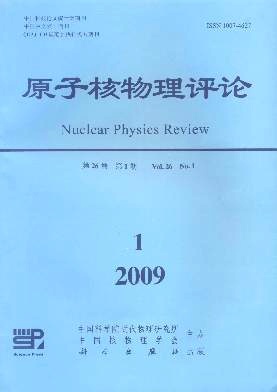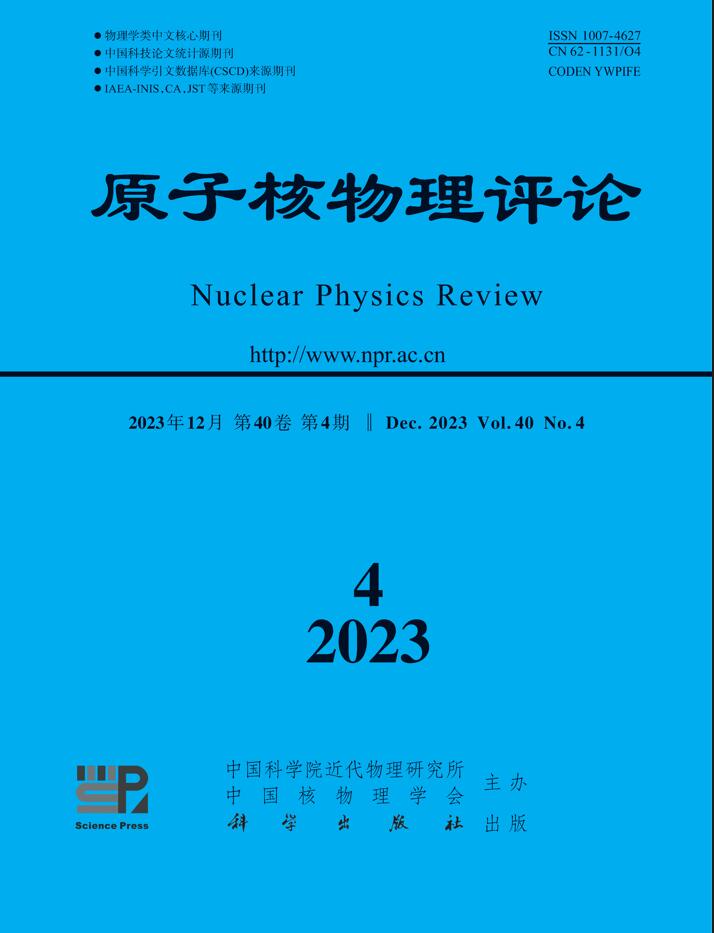2009 Vol. 26, No. 1

Display Method:
2009, 26(1): 1-7.
doi: 10.11804/NuclPhysRev.26.01.001
Abstract:
Using quantum pathintegral formulae,we examined the twokaon and twopion HanburyBrownTwiss (HBT) interferometry for the particleemitting source with high baryon density. The evolution of the source is described by relativistic hydrodynamics. We use an equation of state of firstorder transition from QGP to hadronic phase and consider a volume correction for the hadronic gas. The twopion HBT results with effects of excitedparticle decay and multiple scattering were investigated and compared with those for conventional thermal freezeout (TFO) model. We found that the twokaon HBT radius was smaller than those of the twopion interferometry. The particle decay increases the HBT radius and lifetime, while the effect of multiple scattering on HBT results can be neglected.
Using quantum pathintegral formulae,we examined the twokaon and twopion HanburyBrownTwiss (HBT) interferometry for the particleemitting source with high baryon density. The evolution of the source is described by relativistic hydrodynamics. We use an equation of state of firstorder transition from QGP to hadronic phase and consider a volume correction for the hadronic gas. The twopion HBT results with effects of excitedparticle decay and multiple scattering were investigated and compared with those for conventional thermal freezeout (TFO) model. We found that the twokaon HBT radius was smaller than those of the twopion interferometry. The particle decay increases the HBT radius and lifetime, while the effect of multiple scattering on HBT results can be neglected.
2009, 26(1): 8-12.
doi: 10.11804/NuclPhysRev.26.01.008
Abstract:
Based on the improved isospin dependent quantum molecular dynamics (ImIQMD) model,the reaction of 48Ca+208Pb at energies near the Coulomb barrier was investigated systematically. The capture cross section,the quasifission cross section, the mass distribution of the quasifission fragments and the time for quasifission happened were obtained. According to the comparison with experimental data,the calculated capture cross sections and the fragment distributions of the quasifission were reasonable. Additionally,we got the cross sections of the third largest fragment,and the emission mechanism was also discussed briefly.
Based on the improved isospin dependent quantum molecular dynamics (ImIQMD) model,the reaction of 48Ca+208Pb at energies near the Coulomb barrier was investigated systematically. The capture cross section,the quasifission cross section, the mass distribution of the quasifission fragments and the time for quasifission happened were obtained. According to the comparison with experimental data,the calculated capture cross sections and the fragment distributions of the quasifission were reasonable. Additionally,we got the cross sections of the third largest fragment,and the emission mechanism was also discussed briefly.
2009, 26(1): 13-18.
doi: 10.11804/NuclPhysRev.26.01.013
Abstract:
In this article, the experimental excitation function has been simulated in the numerical method based on R matrix theory and optical model potential, the decay energy and decay partial width of the resonant states have been obtained. Then the spectroscopic factor of the excited state in resonance elastic scattering reaction has been calculated, and it was compared with other experimental results, it shows a good agreement with the experimental data.
In this article, the experimental excitation function has been simulated in the numerical method based on R matrix theory and optical model potential, the decay energy and decay partial width of the resonant states have been obtained. Then the spectroscopic factor of the excited state in resonance elastic scattering reaction has been calculated, and it was compared with other experimental results, it shows a good agreement with the experimental data.
2009, 26(1): 19-22.
doi: 10.11804/NuclPhysRev.26.01.019
Abstract:
The effect of noncommutativity of space have caused the physical academic circles widespread interest. In this paper, the noncommutative (NC) is introduced, which contain noncommutative of coordinatecoordinate, and find that the MoyalWeyl product in NC space can be replaced with a Bopp shift. Then, the energy splitting of the coupling harmonic oscillator in noncommutative spaces are discussed.
The effect of noncommutativity of space have caused the physical academic circles widespread interest. In this paper, the noncommutative (NC) is introduced, which contain noncommutative of coordinatecoordinate, and find that the MoyalWeyl product in NC space can be replaced with a Bopp shift. Then, the energy splitting of the coupling harmonic oscillator in noncommutative spaces are discussed.
2009, 26(1): 23-26.
doi: 10.11804/NuclPhysRev.26.01.023
Abstract:
The radioactive nuclei neutron capture cross section is very important to nuclearsynthesis and nuclide abundance in sprocess, but it is difficult to be measured directly because of the target production. A new method, surrogate ratio method which is developed from surrogate method, could be used to determine the cross section of radioactive nuclei neutron capture. In this paper, the surrogate ratio method was introduced and the feasibility was discussed to deduce the desired neutron capture cross sections with surrogate ratio method.
The radioactive nuclei neutron capture cross section is very important to nuclearsynthesis and nuclide abundance in sprocess, but it is difficult to be measured directly because of the target production. A new method, surrogate ratio method which is developed from surrogate method, could be used to determine the cross section of radioactive nuclei neutron capture. In this paper, the surrogate ratio method was introduced and the feasibility was discussed to deduce the desired neutron capture cross sections with surrogate ratio method.
2009, 26(1): 27-32.
doi: 10.11804/NuclPhysRev.26.01.027
Abstract:
The neutron spectrum in sample place of online neutron activation analysis system was measured with multiple foil activation technique. According to the neutron fluence level of measuring request, 5 kinds of nonfission nuclear material foils were selected, of which 4 were sensitive to thermal energy region and intermediate energy region, and 1 was sensitive to fast energy region. By measuring the foil activity, the neutron spectrum that was needed to measured was unfolded with the iterative methods SANDII and MSIT. Meanwhile, the process of producing and modifying group cross section were analysed amply. The main factors which have influence on the accuracy of the solution were studied. The discussion for solution was done simply, and the uncertainty of solution was analysed by using the Monte Carlo method.
The neutron spectrum in sample place of online neutron activation analysis system was measured with multiple foil activation technique. According to the neutron fluence level of measuring request, 5 kinds of nonfission nuclear material foils were selected, of which 4 were sensitive to thermal energy region and intermediate energy region, and 1 was sensitive to fast energy region. By measuring the foil activity, the neutron spectrum that was needed to measured was unfolded with the iterative methods SANDII and MSIT. Meanwhile, the process of producing and modifying group cross section were analysed amply. The main factors which have influence on the accuracy of the solution were studied. The discussion for solution was done simply, and the uncertainty of solution was analysed by using the Monte Carlo method.
2009, 26(1): 33-36.
doi: 10.11804/NuclPhysRev.26.01.033
Abstract:
Nuclear mass measurement by electron cooling mode in CSRe is discussed, mainly in three related aspects: the systematic error caused by the space charge effect in the case of linear mass calibration; the possibility of mass measurement of 190 Ir in CSRe; the estimation of the attainable precision in the case of nonlinear mass calibration. Theoretic analysis of the attainable precision shows that a precision of σ(m)/m≈10-8 can be achieved if the momentum spread of each kind of ions can be reduced to 10-6 in CSRe.
Nuclear mass measurement by electron cooling mode in CSRe is discussed, mainly in three related aspects: the systematic error caused by the space charge effect in the case of linear mass calibration; the possibility of mass measurement of 190 Ir in CSRe; the estimation of the attainable precision in the case of nonlinear mass calibration. Theoretic analysis of the attainable precision shows that a precision of σ(m)/m≈10-8 can be achieved if the momentum spread of each kind of ions can be reduced to 10-6 in CSRe.
2009, 26(1): 37-40.
doi: 10.11804/NuclPhysRev.26.01.037
Abstract:
A thin wall, fast pulse 252Cf ionization chamber, which was designed for calibrating efficiency of neutron detectors, was described. The ionization chamber can be used as the start detector in timeofflight measurements of the 252Cf fission neutron spectrum. The chamber is composed of 0.15 mm thick stainless steel, the rise time of pulse signals is about 5.5 ns. As the test result shows, the detection efficiency of fission fragments is 99.2%, and pulse signals caused by fissions are distinguished clearly from those caused by α decays.
A thin wall, fast pulse 252Cf ionization chamber, which was designed for calibrating efficiency of neutron detectors, was described. The ionization chamber can be used as the start detector in timeofflight measurements of the 252Cf fission neutron spectrum. The chamber is composed of 0.15 mm thick stainless steel, the rise time of pulse signals is about 5.5 ns. As the test result shows, the detection efficiency of fission fragments is 99.2%, and pulse signals caused by fissions are distinguished clearly from those caused by α decays.
2009, 26(1): 41-43.
doi: 10.11804/NuclPhysRev.26.01.041
Abstract:
Traditional Xray scatheless detecting method is used widely, but it is not useful to discriminate explosive consisting of low Z atomic elements. The penetrability of neutron is much better, and it can interact on atomic nucleus to emit characteristic γ ray. So neutron scatheless detecting methods can the used to detect the low Z atomic elements. In this paper, several neutron scatheless detecting methods are introduced briefly, and the principium experiment using Pulse Fast Thermal Neutron Analysis(PETNA) to detect a kind of explosive simulacrum is carried out. The experiment results show that PFTNA based on the sealed neutron generator is feasible to detect explosive.
Traditional Xray scatheless detecting method is used widely, but it is not useful to discriminate explosive consisting of low Z atomic elements. The penetrability of neutron is much better, and it can interact on atomic nucleus to emit characteristic γ ray. So neutron scatheless detecting methods can the used to detect the low Z atomic elements. In this paper, several neutron scatheless detecting methods are introduced briefly, and the principium experiment using Pulse Fast Thermal Neutron Analysis(PETNA) to detect a kind of explosive simulacrum is carried out. The experiment results show that PFTNA based on the sealed neutron generator is feasible to detect explosive.
2009, 26(1): 44-47.
doi: 10.11804/NuclPhysRev.26.01.044
Abstract:
Ni/SiO2 interface were irradiated at room temperature with 308 MeV Xe ions to 1×1012, 5×1012 Xe/cm2 and 853 MeV Pb ions to 5×1011 Pb/cm2, respectively. These samples were analyzed using Rutherford Backscattering Spectrometry (RBS) and Xray diffraction spectroscopy (XRD), from which the intermixing and phase change were investigated. The obtained results show that both Xe and Pbions could induce diffusion of Ni atoms to SiO2 substrates and result in intermixing of Ni with SiO2. Furthermore, 1.0×1012 Xe/cm2 irradiation induced the formation of NiSi2 and 5.0×1012 Xe/cm2 irradiation created Ni3Si and NiO phases. The diffusion of Ni atoms and the formation of new phase may be driven by a transient thermal spike process induced by the intense electronic energy loss along the incident ion path.
Ni/SiO2 interface were irradiated at room temperature with 308 MeV Xe ions to 1×1012, 5×1012 Xe/cm2 and 853 MeV Pb ions to 5×1011 Pb/cm2, respectively. These samples were analyzed using Rutherford Backscattering Spectrometry (RBS) and Xray diffraction spectroscopy (XRD), from which the intermixing and phase change were investigated. The obtained results show that both Xe and Pbions could induce diffusion of Ni atoms to SiO2 substrates and result in intermixing of Ni with SiO2. Furthermore, 1.0×1012 Xe/cm2 irradiation induced the formation of NiSi2 and 5.0×1012 Xe/cm2 irradiation created Ni3Si and NiO phases. The diffusion of Ni atoms and the formation of new phase may be driven by a transient thermal spike process induced by the intense electronic energy loss along the incident ion path.
2009, 26(1): 48-54.
doi: 10.11804/NuclPhysRev.26.01.048
Abstract:
Lowactivation Ferritic/Martensitic steels are a kind of important structural materials candidate to the application in advanced nuclear energy systems. Possible degradation of properties and even failure in the condition of hightemperature and high helium production due to energetic neutron irradiation in a fusion reactor is a major concern with the application of this kind of materials. In the present work microstructural evolution in a 9Cr Ferritic/Martensitic steel (T92B) irradiated with 122 MeV 20Ne ions at temperatures between 0.3—0.5 Tm (Tm is the melting point of the material) was investigated with transmission electron microscopy. High concentration voids were observed in the specimens irradiated at high temperatures when the displacement damage dose and Ne concentration exceed a certain level. Preferential formation of voids at lathboundaries and other grainboundaries was found. The data of void swellings in 9Cr ferritic/martensitic steels irradiated in different conditions (such as with Heions, Neions, Fe/He dual beams, fast neutrons, Niions etc.) were compiled and analyzed based on a classic model of helium bubble formation, and bubble to void transition.
Lowactivation Ferritic/Martensitic steels are a kind of important structural materials candidate to the application in advanced nuclear energy systems. Possible degradation of properties and even failure in the condition of hightemperature and high helium production due to energetic neutron irradiation in a fusion reactor is a major concern with the application of this kind of materials. In the present work microstructural evolution in a 9Cr Ferritic/Martensitic steel (T92B) irradiated with 122 MeV 20Ne ions at temperatures between 0.3—0.5 Tm (Tm is the melting point of the material) was investigated with transmission electron microscopy. High concentration voids were observed in the specimens irradiated at high temperatures when the displacement damage dose and Ne concentration exceed a certain level. Preferential formation of voids at lathboundaries and other grainboundaries was found. The data of void swellings in 9Cr ferritic/martensitic steels irradiated in different conditions (such as with Heions, Neions, Fe/He dual beams, fast neutrons, Niions etc.) were compiled and analyzed based on a classic model of helium bubble formation, and bubble to void transition.
2009, 26(1): 55-58.
doi: 10.11804/NuclPhysRev.26.01.055
Abstract:
Spinel deposited with a thin Au film was implanted with helium ions, and annealed in vacuum condition subsequently. The surface Plasmon resonance absorbance peak due to the existence of metallic nanoparticles in the dielectric matrix was observed on the UltravioletVisible Spectrometry, indicating the formation of metallic nanoparticles in spinel. The dependence of Au particles size with annealing temperature and implantation doses was also investigated.
Spinel deposited with a thin Au film was implanted with helium ions, and annealed in vacuum condition subsequently. The surface Plasmon resonance absorbance peak due to the existence of metallic nanoparticles in the dielectric matrix was observed on the UltravioletVisible Spectrometry, indicating the formation of metallic nanoparticles in spinel. The dependence of Au particles size with annealing temperature and implantation doses was also investigated.
2009, 26(1): 59-63.
doi: 10.11804/NuclPhysRev.26.01.059
Abstract:
We have studied the structure phase transition of Vanadium under high pressures by density function theory. A mechanical instability in the shear elastic constant (C44) has been found for bodycentred cubic(bcc) Vanadium at about 95 GPa, which indicates the existence of the structural transition. By calculation and analysis, we found that there was a bccrhombohedral structure transition at the 70 GPa, which is consistent with the experiment data. Our calculations also firstly gave that there was a rhombohedralbcc structure transition at about 380 GPa, which needs to be verified by the experiment.
We have studied the structure phase transition of Vanadium under high pressures by density function theory. A mechanical instability in the shear elastic constant (C44) has been found for bodycentred cubic(bcc) Vanadium at about 95 GPa, which indicates the existence of the structural transition. By calculation and analysis, we found that there was a bccrhombohedral structure transition at the 70 GPa, which is consistent with the experiment data. Our calculations also firstly gave that there was a rhombohedralbcc structure transition at about 380 GPa, which needs to be verified by the experiment.
2009, 26(1): 64-68.
doi: 10.11804/NuclPhysRev.26.01.064
Abstract:
The transporting behavior of As, Cs, Sr in vitrification form has been studied using a simulating model of ascending flows.Instrumental Neutron Activation Analysis (INAA) was used to determine the quantity of elements transportation. The results of simulating experiment show that the elements can be transported vertically from the vitrification form by ascending flows in the form of nanoscale particles. Then these elements accumulate continuously in the adsorber above the vitrification form. In addition, when the temperature difference between the ground surface and the environment where the vitrification form disposed increases, the transportation speed of these elements will increase too.
The transporting behavior of As, Cs, Sr in vitrification form has been studied using a simulating model of ascending flows.Instrumental Neutron Activation Analysis (INAA) was used to determine the quantity of elements transportation. The results of simulating experiment show that the elements can be transported vertically from the vitrification form by ascending flows in the form of nanoscale particles. Then these elements accumulate continuously in the adsorber above the vitrification form. In addition, when the temperature difference between the ground surface and the environment where the vitrification form disposed increases, the transportation speed of these elements will increase too.
2009, 26(1): 69-75.
doi: 10.11804/NuclPhysRev.26.01.069
Abstract:
Basic algorithms of biological effective dose optimization and dose distribution on CT image for the heavy ion therapy project at the Institute of Modern Physics (IMP), Chinese Academy of Sciences (CAS) are reported in this paper. Firstly, biological effective dose optimization is conducted in water. According to the relationship between CT number and water equivalent path length, an integral algorithm is used to calculate the average dose within a pixel and then the dose distribution in tissue is derived. Secondly, the dose determination of layerstacking conformal irradiation is described and the layerstacking method is proposed to be applied in twodimensional conformal irradiation. These methods are sufficient to the requirements of the ongoing and future heavyion clinical trials conducted at IMP.
Basic algorithms of biological effective dose optimization and dose distribution on CT image for the heavy ion therapy project at the Institute of Modern Physics (IMP), Chinese Academy of Sciences (CAS) are reported in this paper. Firstly, biological effective dose optimization is conducted in water. According to the relationship between CT number and water equivalent path length, an integral algorithm is used to calculate the average dose within a pixel and then the dose distribution in tissue is derived. Secondly, the dose determination of layerstacking conformal irradiation is described and the layerstacking method is proposed to be applied in twodimensional conformal irradiation. These methods are sufficient to the requirements of the ongoing and future heavyion clinical trials conducted at IMP.
2009, 26(1): 76-79.
doi: 10.11804/NuclPhysRev.26.01.076
Abstract:
The damage of pollen nuclei of Pinus thunbergii induced directly by ion implantation were measured by the laser confocal microscopy technique and the singlecell gel electrophoresis test. The results showed that ion implantation caused the nuclei structure to be damaged, leading to the nuclei degradation. The results of statistical analysis showed that the damage grade of nuclei was very correlative with the ion dosage. The damage degree of DNA in the nuclei at the level of single cells was increased with the increase of the ion implantation dose.
The damage of pollen nuclei of Pinus thunbergii induced directly by ion implantation were measured by the laser confocal microscopy technique and the singlecell gel electrophoresis test. The results showed that ion implantation caused the nuclei structure to be damaged, leading to the nuclei degradation. The results of statistical analysis showed that the damage grade of nuclei was very correlative with the ion dosage. The damage degree of DNA in the nuclei at the level of single cells was increased with the increase of the ion implantation dose.
2009, 26(1): 80-83.
doi: 10.11804/NuclPhysRev.26.01.080
Abstract:
To study the effects of radiation sterilization of the electron beam, the three species of microorganisms, Escherichia. coli, Staphylococcus aureus and Proteus vulgaris were irradiated with the electron beam, delivered by the electron accelerator independently developed by the Institute of Modern Physics, Chinese Academy of Sciences, and the changes of superoxide dismutase (SOD) activity of these irradiated microorganisms were also tested. The results indicated that the Staphylococcus aureus were fully radiosterilized with the radiation dosage of 2.0 kGy, but 2.2 kGy to the Escherichia.coli and Proteus vulgaris. Moreover, the data also demonstrated that the irradiation had noticeable effects on the SOD activity of the three microorganisms.
To study the effects of radiation sterilization of the electron beam, the three species of microorganisms, Escherichia. coli, Staphylococcus aureus and Proteus vulgaris were irradiated with the electron beam, delivered by the electron accelerator independently developed by the Institute of Modern Physics, Chinese Academy of Sciences, and the changes of superoxide dismutase (SOD) activity of these irradiated microorganisms were also tested. The results indicated that the Staphylococcus aureus were fully radiosterilized with the radiation dosage of 2.0 kGy, but 2.2 kGy to the Escherichia.coli and Proteus vulgaris. Moreover, the data also demonstrated that the irradiation had noticeable effects on the SOD activity of the three microorganisms.







 甘公网安备 62010202000723号
甘公网安备 62010202000723号